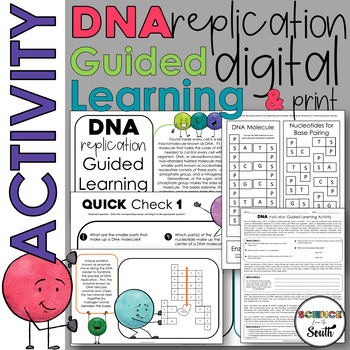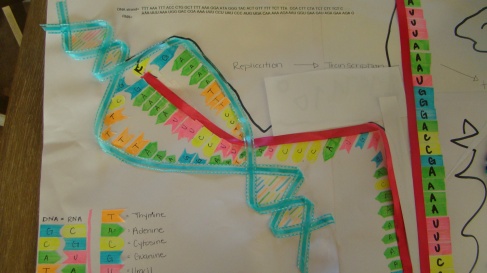DIY Zombie- Apocalyptic Summer Learning Camp, Phase I, part B: Zombies and Mutations
For our scenario, our creatures are humans that because of an outside force become mutants and obtain some of the qualities of some sort of creature, whether you choose zombie, vampire or another such monster. Students, therefore, review or learn about how mutations occur.
A gene mutation is a permanent alteration in the DNA sequence that makes up a gene, making the sequence differ from what is found in most people. Mutations can affect anywhere from a single DNA building block (base pair) to a large segment of a chromosome that includes multiple genes. There are two types of gene mutations. Hereditary mutations are inherited from a parent and are present throughout a person's life in virtually every cell in the body. Acquired mutations, sometimes called somatic mutations, occur at some time during a person's life and are present only in certain cells. These changes can be caused by environmental factors or can occur if a mistake is made as DNA copies itself during cell division.
In order to learn about gene mutations, students have to know some about DNA structure, nucleotides and DNA replication. Depending on your students' studies, this may be new to them or it may be review.
DNA Structure
We have built models of DNA before, using various components.
After students have learned the structure of DNA, they can begin to learn about DNA replication.
 |
| source |
Types of Gene Mutations
Next they can learn about genetic mutations and how they occur.
This is a direction quotation from Genetics Home Reference: What Kinds of Gene Mutations Are Possible?
- Missense mutation: This type of mutation is a change in one DNA base pair that results in the substitution of one amino acid for another in the protein made by a gene.
- Nonsense mutation A nonsense mutation is also a change in one DNA base pair. Instead of substituting one amino acid for another, however, the altered DNA sequence prematurely signals the cell to stop building a protein. This type of mutation results in a shortened protein that may function improperly or not at all.
- Insertion An insertion changes the number of DNA bases in a gene by adding a piece of DNA. As a result, the protein made by the gene may not function properly.
- Deletion A deletion changes the number of DNA bases by removing a piece of DNA. Small deletions may remove one or a few base pairs within a gene, while larger deletions can remove an entire gene or several neighboring genes. The deleted DNA may alter the function of the resulting protein(s).
- Duplication A duplication consists of a piece of DNA that is abnormally copied one or more times. This type of mutation may alter the function of the resulting protein.
- Frameshift mutation This type of mutation occurs when the addition or loss of DNA bases changes a gene's reading frame. A reading frame consists of groups of 3 bases that each code for one amino acid. A frameshift mutation shifts the grouping of these bases and changes the code for amino acids. The resulting protein is usually nonfunctional. Insertions, deletions, and duplications can all be frameshift mutations.
- Repeat expansion Nucleotide repeats are short DNA sequences that are repeated a number of times in a row. For example, a trinucleotide repeat is made up of 3-base-pair sequences, and a tetranucleotide repeat is made up of 4-base-pair sequences. A repeat expansion is a mutation that increases the number of times that the short DNA sequence is repeated. This type of mutation can cause the resulting protein to function improperly.

Additional learning activities:
For a ready made activity, you can use Zombie Protein Synthesis activity at Ashley 's Interactive Biology Notebooks.
Literature Study: Apocalyptic Novels
For this week's Literature Circle, you might want to discuss the setting in Apocalyptic novels. Encourage them to cite examples from the texts they are reading.
Next Week
Their next activity will be to infiltrate the zombie lair in order to obtain a sample of their DNA to find out which mutation occurred.
Other related activities:
- Read this interesting article entitled 5 Real Diseases that Could Make You Act Just Like a Zombie.
- Research Renfield Syndrome.




